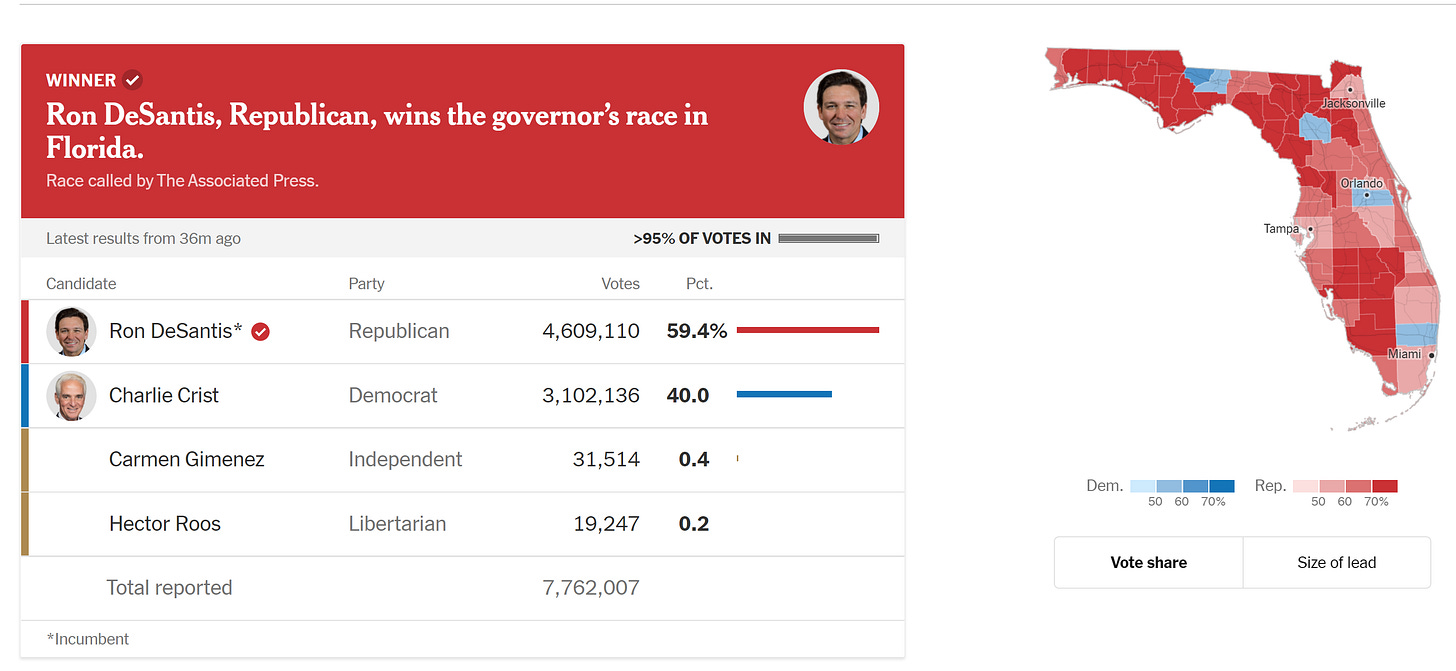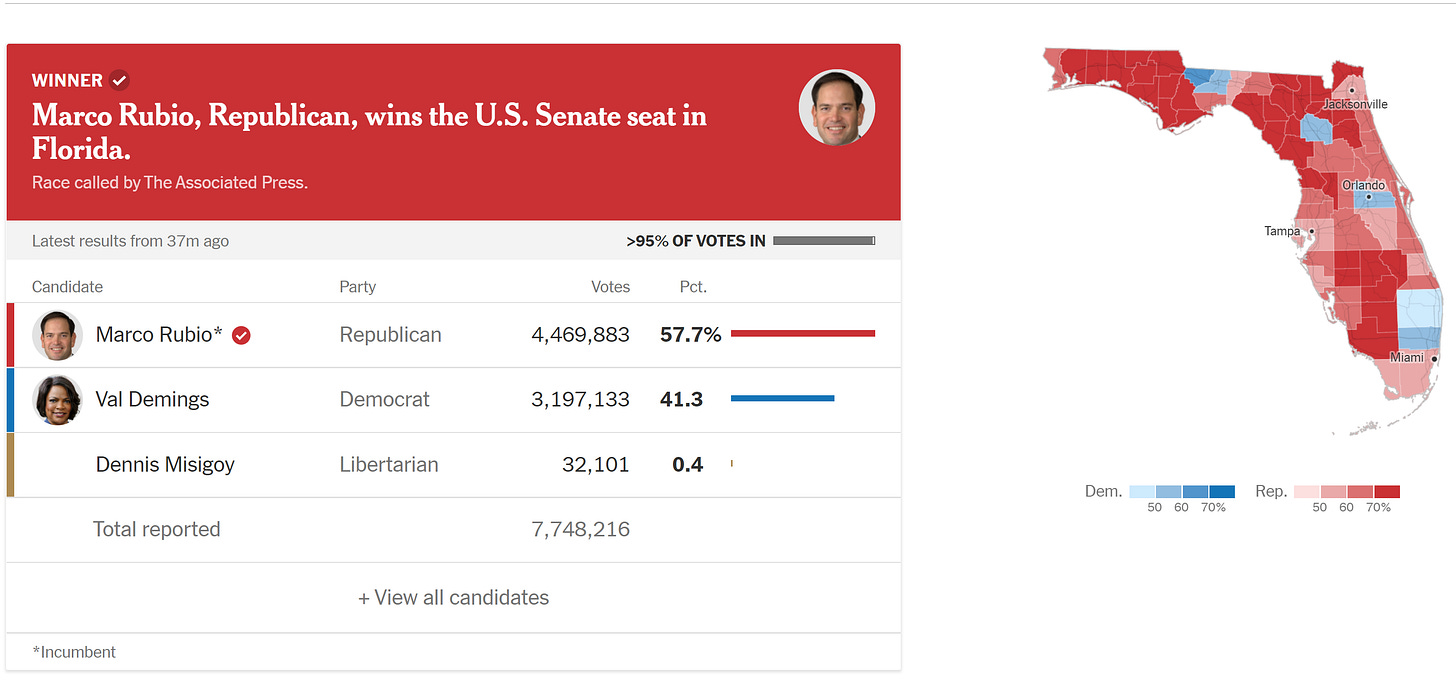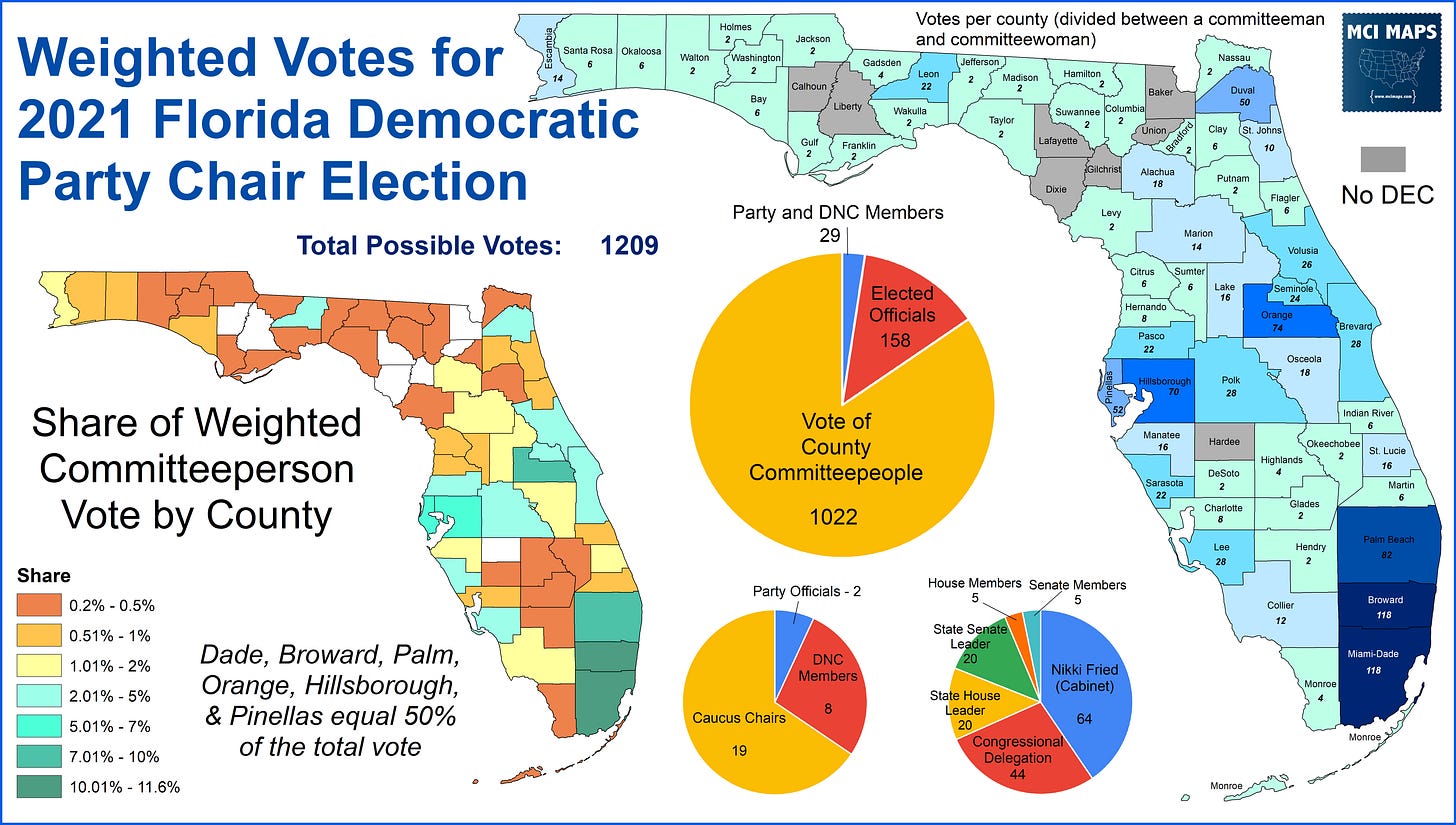Issue #80: REVOLT among FL Democrats - Chair Diaz in crosshairs
A horrible night for Florida Democrats
On Tuesday, Florida Democrats and national Democrats had VERY different election nights. Nationally, Democrats have a real shot at holding the US Senate: flipping Pennsylvania, and are in the game for Nevada, Arizona, and Georgia. On the US House front, Democrats held several districts they risked losing, and flipped others. GOP control of the US House is still likely, but this is a very mixed-result midterm, which for a party in power, is a good night.
Election Night in Florida
In Florida, the story is very different. Even before the polls closed, it was clear to any data watchers, like myself, that the results were going to be bad. Heading into election day, I was tracking early/absentee ballots, and seeing a very bad omen. GOP turnout was good, Democratic turnout was cratering. Even before election day, Republicans had a real solid turnout advantage.
On election day itself, the picture looked even bleaker. Republicans were showing up, Democrats were staying home. When the polls closed in the east at 7pm, it was clear that not only would the statewide races would go red, but that many down-ballot democrats were in trouble.
The margins, however, were unprecedented for modern Florida.
The races for Governor and Senator was massive GOP wins. Miami-Dade, Hillsborough, Pinellas, Duval, Seminole, and Palm Beach all went from Biden to the GOP. Democratic margins in the remaining blue pockets all shrunk from 2020.
In Miami-Dade, Ron DeSantis became the first Republican to win the county since Jeb Bush in 2002.
Now, I will of course be doing detailed analysis in the coming days and weeks. Precinct data is being collected, and I am eager to get the final voter list, so we can see exactly who showed up vs who didn’t. What is very clear, however, is how much turnout drove these massive swings. The early voting data painted a clear picture, but so did final turnout. I included the turnout map in the Dade image to highlight this point. For example, turnout was much weaker in the counties’ African-American community than in the white and Hispanic areas.
The party turnout data at a county-by-county level shows a very clear picture, Republicans surpassed Democrats across the board. Every major urban county saw a larger % of registered Republicans show up vs Registered Democrats. In counties like Miami-Dade and Osceola, the gap was over 15 points.
I have not finished data collection yet, but the average here is that GOP turnout was over 10 points higher than Democratic turnout. This is unprecedented.
The story of 2022 in Florida isn’t just about messaging, though I imagine that will be the talking point. No, its about turnout. Democrats did not show up.
You Need Money
Why didn’t they show up? A major reason is resources. Anybody working elections in Florida knows what I am talking about. 2022 was the most lopsided the two parties were in terms of resources. Democrats, running on a skeleton crew due to so little cash, did not have the ability to run sophisticated GOTV operations. Republicans, however, have been able to build a massive operation to register and turn out voters. I am talking paid canvassing, regional field office, phone banks, and so on. This stuff is not cheap or free. Think back to Barack Obama in 2008 and 2012 - and his Organizing for America operation. The campaign had field offices that volunteers could go to and get signs, literature, and sign up for phone bank and canvassing shifts. Well, Obama’s campaign paid for this offices and lots of paid field staff. That isn’t organic or free. The Obama field campaigns were hundreds of millions in cost. Republicans have these operations now. Florida Democrats do not.
On top of this, Republicans used their massive resource advantage to block out the sun in ads. The put several legislative districts in their hands by dumping millions into districts where Democrats could not compete.
The disparity led to Democrats losing two Incumbent Senators, Janet Cruz and Loranne Ausley. Multiple Democratic house incumbents were knocked out. The most telling loss was that of Rep Carlos Smith, who’s 11 point Obama district saw GOP interests throw over $1 million dollars to ousting him.
Smith, meanwhile, needed to answer the attacks thrown at him AND try to get student turnout at the University of Central FL up. He could only do so much on his own, and student turnout wound up only being 38%. Smith lost his race. The Florida Senate will have gone from 24 Republicans and 16 Democrats to 28 Republicans and 12 Democrats. The State House goes from 78-42 to 85-35.
With Democrats sitting at the rock bottom of influence in the state, the calls for heads to role in the state party have reached a fever pitch.
Election - and Ousting - A Party Chair
Now, let me make one thing clear. I don’t care who party chair was before this election, they would have been in a horrible position. Post 2020, the Democratic Party of Florida was broke. Trump had won the state comfortably, the party was divided, and national groups were not looking at Florida as a long term focus. Fixing all that in two years would have been impossible. Raising money and rebuilding a political structure is not easy. In early 2021, the Florida Democratic Party elected Manny Diaz, a former Mayor of Miami, to be party chair. The goal was simple, begin rebuilding the party. It wouldn’t happen in one cycle, but it had to begin.
And in Diaz’s defense, the money disparity is still the biggest story. Diaz’s side has pointed out that in 2018, national Democratic groups put over $50,000,000 into Florida. This time, it was less than $2,000,000. DeSantis was able to block out the sun with ads, while Crist (and Fried, so lets not relitigate the primary) struggled to raise money.
However, even before the election, growing anger was building. The lack of proper coordinated campaigns was decried, with many county-level orgs feeling their was not even the loosest of connections with statewide operations. Ok sure, the money isn’t there for a crazy expensive field operation, but lack of communication was CONSTANT complaint I saw and heard.
Then, just two weeks ago, Diaz generated tremendous anger when he announced a list of endorsements for local races. This included endorsing Democrats against fellow Democrats in non-partisan Mayoral contests. Right here in Tallahassee, Diaz endorsed Mayor John Dailey, who was in a runoff against fellow Democrat Kristen Dozier. This drew local condemnation from the Leon County Democratic Party, who responded by endorsing Dozier directly in retaliation. The move by Diaz to back Dailey was incredibly dumb simply due to the fact it only served to divide Democrats. On top of this, Dailey (who did win his runoff two days ago) had come in 2nd in his first round with Dozier.
On top of this, Dailey was being heavily funded by developers and utilities, and backed by North-Tallahassee Republicans, in his race. Endorsing Dailey felt like betrayal of the left-side of the Democratic caucus. It makes it hard, if not impossible, for Diaz to be seen as a unifying force.
As a result of all this, the talk of Diaz being forced out is growing. Even before the elections, a rumor leaked that Diaz would resign. He appears to not be keen on that. However, it is clear the wagons are circling for him. Nikki Fried floated the idea, for a couple hours, about running for Party Chair, but has backed out.
So lets say Diaz resigns, or is forced into a vote of no confidence. How do these elections work?
How Chair Elections Work
Elections of party chair are dominated by party officials. Who is that? Well, the biggest voting block in any party chair election is the people from the county parties. Per the rules, every county in Florida can have a county party. These organizations are officially chartered through the state organization, and even have rules governing them codified in Florida statute. Each county party is made up of people who are representing their voter precinct. So let me game this out here…
Lets say you live in Leon County and want to join the Leon Democratic Party
You go to a meeting and say you want to join. You get the paperwork
You would represent your voter precinct. Lets say its Precinct 5203
If no one currently represents your precinct, boom your in. Note every county allows a male and female precinct person.
If your precinct already has someone, you can serve at-large, but this can come with some restrictions
In Presidential years, in the August primary, you actually RUN for election to your precinct. These elections are run by the county - same ballot as regular races.
Precinct representatives then elect county party leadership at a party meeting
Now, back in the day, precinct races used to be super competitive! Back when county parties had a good deal of influence. These days its more likely than not you’d be the only person running in your precinct. Also note this is all very simplistic and ignores differences in counties - like many large counties allow more than 1 person per precinct if it has more than 1,000 registered democrats in it.
The county leadership is what is critical for the state party here. These precinct leaders, every 2 or 4 years, elect a County Chair and Committeepeople. What is a Committeeperson? That is the male and female representative to the state party. Every county elects a man and women. THESE people are who control a vast majority of votes for State Party positions.
And, per party rules, each county committeeperson has their votes weighted by the size of the county. The exact formula, which is based on general election voting, is not important here. But long story short, a committeeman for Miami-Dade has FAR more power than the committeeman for Jefferson. In 2021, when Manny Diaz was elected, this was the breakdown of votes weight.
Of the 1209 possible votes a person could get, 1022 were decided by the County Committeepeople. So for example, Hillsborough had 70 weighted votes. That meant its Committeeman got 35 votes, while the Committeewoman got 35 as well. So if you were a committeeperson for a major county, your vote mattered much more than the smaller counties.
In addition to the committeepeople, different party officials have votes, namely caucus chairs and DNC members. In addition, Democratic elected officials get votes, with the most going to any statewide Democrat. However, both these groups pale in comparison to the committeepeople.
In that 2021 race, Manny Diaz won the Chair Election on the first ballot, securing a majority of the weighted vote. Notably, he came just short of a majority of the vote of the committeepeople, but pulled ahead with overwhelming backing from elected officials and caucus heads. His main opponent was Ione Townsend, who had the backing of more progressive groups.
The Florida Democratic Party has gone through many chairs in the last decade. On the constant losing end of cycles, it has been hard for chairs to hold the position. On the plus side, we have many chair elections to look at.
The importance of the weighting of the vote for committeepeople was best seen in 2013. That year, Allison Tant, now a State House member, narrowly defeated Alan Clendenin for the Party Chair Post.
I don’t have the caucus/official votes, but Tant was able to narrowly defeat Clendenin with committee votes. However, thanks to Clendenin having the largest counties in his pocket, it took a united small county front to get Tant the post. She narrowly won the weighted vote despite taking over 75% of the actual people casting ballots.
Tant held the post for 4 years, and call be biased but I wish she would come back. After 2016, she stepped aside, and Democrats elected Stephen Bittel, a prominent Miami-Dade fundraiser.
However, Bittel did not last long. After 9 months on the job, where he did little to help the party, he was forced out after sexual harassment allegations. Democrats called a special meeting to elect a new chair. The elected Terri Rizzo, the Chair of the Palm Beach Democratic Party.
Rizzo was then ousted after the 2020 elections, which led us to Diaz as chair.
So are we heading to another ousting and another Chair election? I think it is more likely than not. Is Diaz to blame for all the problems Florida Democrats face? No. Has he done anything to help his case to stay? I don’t think so. The lines of communication in the party must improve. The inter-party endorsements were stupid. Diaz likely needs to just fall on his sword.
But, regardless if Diaz goes or stays. The reality is a solution to Florida Democratic woes is NOT simple or easy. Anyone summing up FDP problems with one or two tweets is lying to you about the problems. I have barely scratched the surface of anything here, and this post is already far longer than I planned it to be.
Florida Democrats are in the wilderness. Not only that, they are currently being chased by a bear and have a snake wrapped around their neck.
Surviving all that isn’t going to be easy.















Great work! Thanks for your hard work and helping us understand the 'big picture.'
Manny gets kudos for bringing the party out of near insolvency and putting the first ever paid folks on the ground early to register voters, something Steve Schale preached had to happen long before election day. Heck, I was grateful that after he was elected, we finally had a working elevator and a warm body at FDP headquarters in downtown Tallahassee! I agree the Chair should not have endorsed anyone - bad judgement all the way around on this one and I'm still spitting bullets over it. That said, somebody tell me who we got better to take his place? Maybe we should talk County DEC leadership and level of activity instead - how many actually had their people on the ground registering and engaging voters, filled precinct slots with folks actively building relationships with their neighbors, making sure they were vote ready and educated on the candidates and issues? How many raised money to GOTV for our candidates? Recruited them? I look forward to more insights, Matt. Not surprised by any of these; just wish there was a way to prove that we getting back to what DECs are charged to do regardless of who is at the top works.